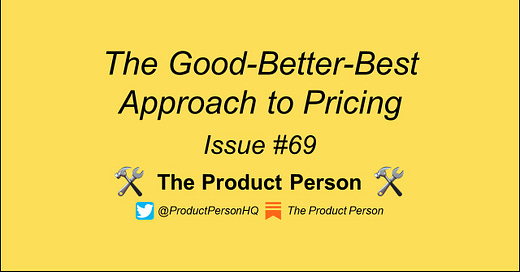The Good-Better-Best Approach to Pricing
Hey, Nick here! In this newsletter, I curate insights and timeless principles on how to build great products. You’ll improve your product skills with every issue.
Here’s an article for you today…
The Good-Better-Best Approach to Pricing
Good-Better-Best pricing is a concept of adding or subtracting product features to “create variably priced bundles targeted to customers of varying economic means or those who value features differently.” From ride sharing to SaaS to a gas pump, we see tiered pricing all over the place.
Here are four reasons why you should implement G-B-B pricing:
Increase margins by creating a high-end “Best” option
A low price “Good” option can make your product more accessible to price-sensitive customers
A “Best” option can boost the reputation of your brand
A “Good” option gets people in your ecosystem and you can sell complementary goods and services
Creating tiered pricing draws on consumer psychology. You can differentiate your product from others by offering tiers. It also shifts the customer from a binary “buy / don’t buy” decision to figuring out the incremental value provided by the next tier up. A set up of three choices also can create the Goldilocks effect where the consumer typically chooses the middle option.
Three questions are key when thinking of what features should be in an offering:
Does a feature have mass appeal or low appeal?
How would adding or subtracting it affect the cost of producing the good or offering the service?
Is it a “fence” attribute - one that constitutes a barrier preventing existing customers from crossing over to something cheaper?
You should first think about your “fence” attributes as this is usually the most difficult part of the process. Fence attributes help prevent the downward shift of customers from Better to Good. It’s important to put the attributes that have wide and deep appeal.
“To ensure sharp distinctions between offerings, no more than four attributes should differ between Good and Better and between Better and Best. And it’s important to maintain a consistent progression of benefits from Good to Better to Best—beneficial features in Good should be retained in the higher-priced offerings so that every step up the ladder is a clear improvement.”
When it comes to pricing, it is suggested that Good pricing shouldn’t be more than 25% less than Better and Best shouldn’t be more than 50% compared to Better. For context, companies expect 10% - 20% of revenue from Good, 25% - 50% from Better, and 30 - 60% from Best.
Link to the full article by Rafi Mohammed.
End Note
Thank you for reading. If this was shared to you, you can subscribe here.
For bite-sized product tips in your Twitter feed, follow @ProductPersonHQ.
Have a great day,
Nick



